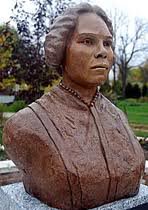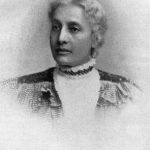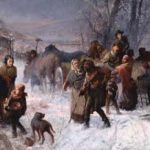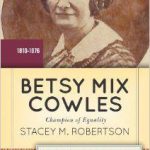Abolitionist, Educator and Suffragist in the Civil War Era

BME Freedom Park
Chatham, Ontario
Mary Ann Shadd (1823–1893) was an anti-slavery activist, journalist, teacher and lawyer. She was the first black woman newspaper publisher in North America and the first woman publisher in Canada. Shadd was one of the most outspoken and articulate female proponents of the abolition of slavery of her day. She promoted equality for all people and taught former slaves how to be self reliant.
Early Years
Mary Ann Shadd was born October 9, 1823 in Wilmington, Delaware, the eldest of 13 children of Abraham and Harriett Shadd, both free-born blacks. Her father was active in the Underground Railroad and a subscription agent for William Lloyd Garrison’s abolitionist newspaper, The Liberator. As a child, Mary Ann witnessed the effects of slavery on the runaway slaves who took shelter in her father’s home.
Delaware was still a slave state and the education of blacks was illegal, so Mary Ann’s parents moved to West Chester, Pennsylvania, where they enrolled her in a Quaker school at the age of 10. She studied there for the next 6 years, then the family moved back to Wilmington.
Career in Education
In 1840, 16-year-old Mary Ann Shadd opened a school for African American children. From 1839 to 1850 she taught, first at the Wilmington school and subsequently at black schools in New York City, Trenton, New Jersey, and West Chester and Norristown, Pennsylvania, everywhere echoing her father’s view that education, thrift and hard work were the means by which blacks could achieve integration in America.
These views appear in Hints to the Colored People of the North, a 12-page pamphlet Shadd published in 1849 that pointed to the folly of blacks imitating the materialism of whites. In accordance with the legacy of her father’s political activism, Shadd implored blacks to take the initiative in anti-slavery reform. Only in her mid 20s, she gained recognition by articulating what would become her perennial themes: black independence and self respect.
The infamous Fugitive Slave Law of 1850 threatened to return northern blacks and escaped slaves to bondage. African Americans who had been free for years were arrested, and their property was taken from them. Whole families were seized in the dead of night, beaten, and dragged back into slavery.
Shadd and her brother Isaac – along with scores of other African Americans – fled to Windsor, Ontario, Canada, directly across the border from Detroit, Michigan. Almost all of her immediate family eventually emigrated there as well. In Windsor, Shadd established a racially integrated school with the aid of the American Missionary Association.
Career in Social Reform
In the United States, there was a campaign to deter runaway slaves from seeking refuge in Canada, so in 1853 Shadd founded a newspaper called The Provincial Freeman with the support of newspaper editor and minister Samuel Ringgold Ward. This weekly publication was dedicated to informing fugitive slaves of the many opportunities available in Canada, and thousands of men, women and children crossed the border to safety.
Publication was then suspended for a year while Shadd traveled in the United States and Canada on a lecture tour to increase subscription and to publicly solicit aid for runaway slaves, at great risk to her own welfare. Shadd revived the paper a year later in Toronto, with the motto “Self-Reliance is the True Road to Independence,” promoting temperance, moral reform, civil rights and black self-help while attacking the racial discrimination blacks faced in North America.
Shadd believed that separate churches, schools and communities for blacks would ultimately undermine the search for freedom. She campaigned for equality and integration for black people, making public speeches and addressing issues of abolition and other reforms.
During this time, Shadd returned to America from time to time, speaking out against slavery and for equal rights for women, unmindful of the threats to her personal safety. To be an outspoken female and an African American only doubled the dangers she shared with her fellow abolitionists, Abby Kelley, Lucretia Mott and Lucy Stone.
In January 1856 Shadd married black businessman Thomas Cary. The couple lived in Chatham, Ontario, and had two children, Sarah and Linton. Shadd continued to publish her newspaper whenever possible and taught school, while aiding runaways in every possible way.
Regular publication of The Provincial Freeman was interrupted several more times because of financial problems. After 1856, it appeared only sporadically and by 1859, when the financial burden had become too debilitating, publication ceased entirely. Shadd remained in Chatham and returned to teaching. Thomas Cary died in 1860.
Yet she watched with great interest as the sectional crisis intensified in the United States. Her hope for the destruction of slavery had been heightened by John Brown’s arrival in Canada in the spring of 1858. Part of a group that met with Brown, Shadd became privy to his plans. Another member of the group, Osborne Perry Anderson, a young black, was so taken with Brown that he joined him at Harpers Ferry in October 1859 and survived the failed raid to record his memoirs in A Voice from Harper’s Ferry, edited and prepared for publication by Shadd.
The Civil War
Through the early years of the Civil War, Shadd continued to teach in an interracial school in Chatham. But she soon grew tired of watching the conflict from a distance. Shadd and her children returned to the United States in 1863, when President Abraham Lincoln called for 500,000 men to serve in the Union Army, and Shadd assisted in enlisting a regiment of African American soldiers.
Shadd agonized over whether to remain in the United States after Appomattox. She finally concluded that she could best serve her people by remaining to help with the education and assimilation of the millions of newly emancipated blacks. Toward this end, in July 1868 she taught briefly in Detroit before relocating in Washington, DC. There, Shadd served as principal to three large schools for seventeen years.
In 1881, Shadd joined the National Woman’s Suffrage Association, working alongside suffragists Susan B. Anthony and Elizabeth Cady Stanton, and testifying before the Judiciary Committee of the House of Representatives. Shadd was called The Rebel by her own family.
In 1881, Shadd entered The Howard University Law School, graduating at the age of 60 in 1883, becoming only the second black woman to earn a law degree in the United States. She resigned from her school positions and spent the balance of her life practicing law. Little is known of her legal practice, but she is recognized as one of the first black female lawyers in the country.
Debilitated by rheumatism and cancer, Mary Ann Shadd Cary died June 5, 1893 in Washington, DC.
As educator, abolitionist, editor, attorney and feminist, Mary Ann Shadd devoted her entire life to improving the quality of life for everyone, be they black or white, male or female. Her former residence in Washington, DC was declared a National Historic Landmark in 1976. In 1987 she was designated a Women’s History Month Honoree by the National Women’s History Project. She was also honored by Canada as a Person of National Historic Significance.
SOURCES
Wikipedia: Mary Ann Shadd
The Life and Times of Mary Ann Shadd Cary
Dictionary of Canadian Biography: Mary Ann Shadd Cary





